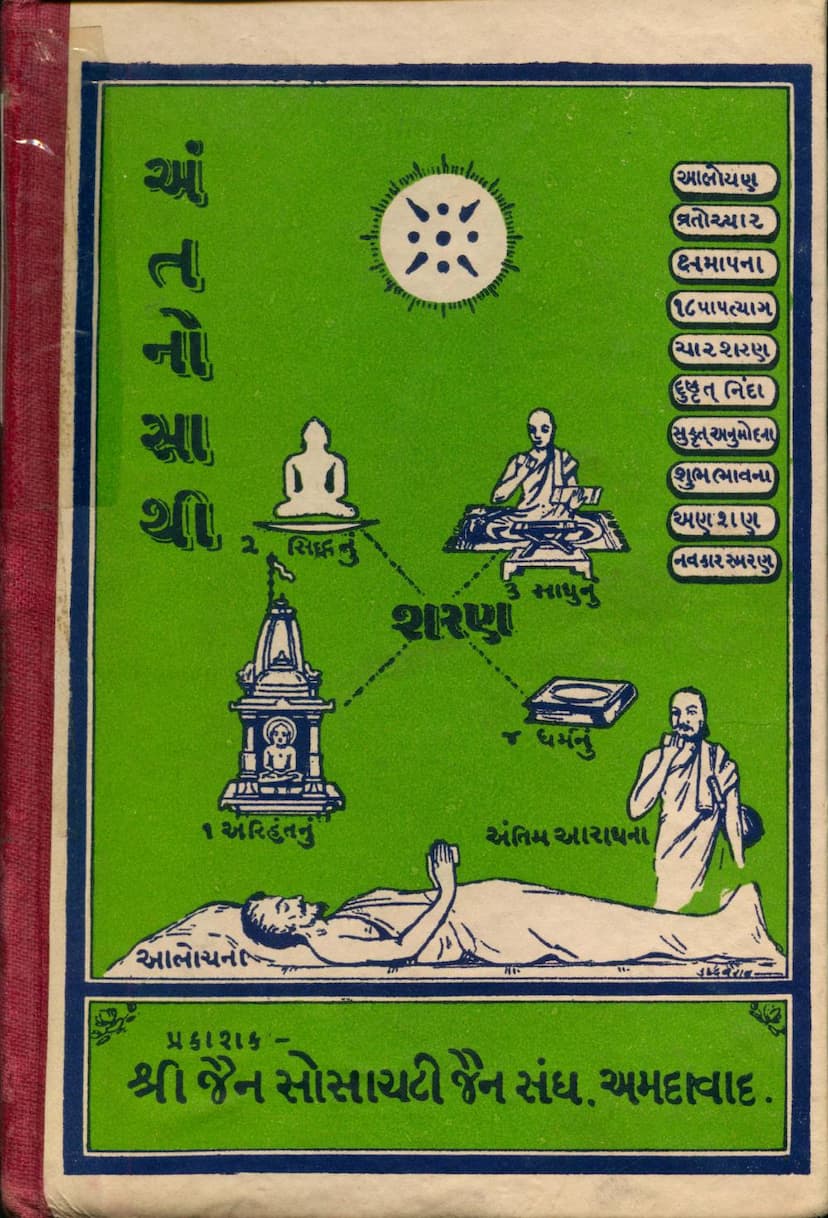Antno Sathi
Added to library: September 1, 2025

Summary
Here's a comprehensive summary of the Jain text "Antno Sathi" (The Companion in the End), based on the provided pages:
Book Title: Antno Sathi (The Companion in the End) Author(s): Muni Shri Chandrodaysagarji Maharaj, Muni Shri Kanchanvijayji, Chimanlal Dalsukhbhai Gandhi Publisher: Shri Jain Society Jain Sangh, Ahmedabad Catalog Link: https://jainqq.org/explore/023106/1
Overall Purpose: "Antno Sathi" is a collection of sacred texts and hymns compiled to guide individuals in their spiritual practice, particularly during the crucial final moments of life. The book emphasizes the importance of mindful preparation and adherence to Jain principles to achieve a peaceful and auspicious death (Samadhi Maran), leading to a favorable rebirth and eventual liberation.
Key Themes and Content:
-
Introduction and Dedication:
- The book is dedicated to the esteemed Acharya Shri Anandsagarsurishwarji Maharaj, recognizing his profound contribution to Jain scripture preservation and propagation.
- The compilation was undertaken during the Chaturmas (monsoon retreat) of Muni Shri Chandrodaysagarji Maharaj and Muni Shri Jinendrasagarji, inspired by the teachings on the importance of "Paryanņas" (sacred texts) for end-of-life spiritual practice.
- The editors, Muni Kanchanvijayji and Chimanlal Dalsukhbhai Gandhi, are acknowledged for their meticulous work.
- The publisher, Shri Jain Society Jain Sangh, expresses gratitude to all contributors and patrons.
-
Core Principles of End-of-Life Sadhana (Aaradhana):
- The text highlights that the end of life is not merely an end but a critical juncture that shapes future destinies. Just as a traveler prepares for a journey, one should prepare for the final departure from mortal life.
- Emphasis is placed on introspection, detachment from worldly possessions (Moh, Mamata), and the practice of core Jain tenets.
- Key spiritual practices recommended for this phase include:
- Alochana (Confession): Repenting for violations of vows (Aticharas).
- Vows and Commitments: Renewing or taking vows afresh.
- Kshama-Pana (Forgiveness): Seeking and granting forgiveness to all beings.
- Renunciation of Eighteen Papsthanaks (Sinful States): Actively abandoning vices.
- Char Sharana (Four Refuges): Seeking refuge in Arihant, Siddha, Sadhu, and Dharma.
- Dushkrit Ninda (Condemnation of Wrongdoings): Self-reproach for past errors.
- Sukrit Anumodana (Appreciation of Good Deeds): Rejoicing in virtuous actions of oneself and others.
- Shubh Bhavana (Auspicious Thoughts): Cultivating positive and spiritual contemplation.
- Anshan (Fasting): Undertaking voluntary fasting as a spiritual discipline.
- Navkar Mantra Remembrance: Constant remembrance of the Mahamantra (Namaskar Maha Mantra).
-
Detailed Contents (Chapters/Sections): The book is structured into various sections, each focusing on a specific sacred text or aspect of spiritual practice:
- Namaskar Mahamantra: The fundamental five-line mantra of Jainism.
- Chatuhsharana Prakirnak: The "Four Refuges" text, detailing the importance of taking refuge in Arihant, Siddha, Sadhu, and Dharma. This section explains the spiritual significance and practice of seeking these refuges.
- Bhaktaparigjna Prakirnak: This section elaborates on "Bhaktaparigjna," a specific type of fasting and spiritual discipline undertaken with devotion, often leading to a peaceful death. It discusses various types of death and the methods for achieving a virtuous end.
- Atur Pratyakhyana Prakirnak: This text deals with "Atur Pratyakhyana," a spiritual resolution undertaken during illness or distress, focusing on detachment and peaceful departure. It outlines specific practices for the dying and the spiritual benefits derived.
- Santhanara Parasi: This section likely discusses the "Santhanara" (the act of preparing for and accepting death), possibly with rituals and ethical considerations.
- Vitragastotra Prakash 17: A specific chapter from a hymn praising the Tirthankaras and the path of liberation.
- Pap Pratighat - Gunbij Adhan: This section focuses on warding off sins and cultivating virtues, likely detailing specific sutras for spiritual purification.
- Chaturgati Jiv Kshamanakula: A text for seeking forgiveness from all souls across the four realms of existence, reflecting the Jain principle of universal compassion.
- Paryant Aaradhana: The "Ultimate Sadhana," a comprehensive guide to end-of-life practices, covering the ten mentioned spiritual disciplines in detail.
- Char Sharana: A concise summary of the four refuges, reiterating their significance.
- Padmavati ki Aaradhana: A section dedicated to the worship of Goddess Padmavati, often associated with protection and prosperity, likely included for spiritual support.
- Punyaprakash Stavan: A hymn or devotional song that illuminates the concept of merit (Punya) and its role in spiritual progress.
- Atmabhavna: This section focuses on self-contemplation and understanding the true nature of the soul, aiming to foster spiritual awareness and detachment.
-
Philosophical Underpinnings:
- Anitya Bhavna (Impermanence): The text repeatedly emphasizes the transient nature of life and all worldly possessions, encouraging detachment.
- Karma Theory: The concept of karma and its influence on one's destiny, particularly at the time of death, is implicitly present.
- Samadhi Maran (Peaceful Death): The ultimate goal is to achieve a death free from mental turmoil, achieved through consistent spiritual practice and preparedness.
- Renunciation and Detachment: The importance of letting go of attachments to family, wealth, and body is stressed for a successful spiritual end.
-
Structure and Style:
- The book primarily uses Gujarati, with occasional Sanskrit invocations.
- It compiles various "Prakirnaka" (auxiliary scriptural texts) and "Stavans" (hymns/devotional songs).
- The language is devotional and instructional, aiming to inspire and guide the reader.
In Essence: "Antno Sathi" serves as a spiritual guide, particularly for those nearing the end of their lives or seeking to understand the Jain perspective on death and liberation. It provides a framework of practices, hymns, and philosophical reflections designed to foster a state of equanimity, detachment, and devotion, ensuring a noble end and a positive spiritual trajectory. The book is a testament to the Jain emphasis on mindful living and dying, viewing death not as an end, but as a transition towards ultimate freedom.